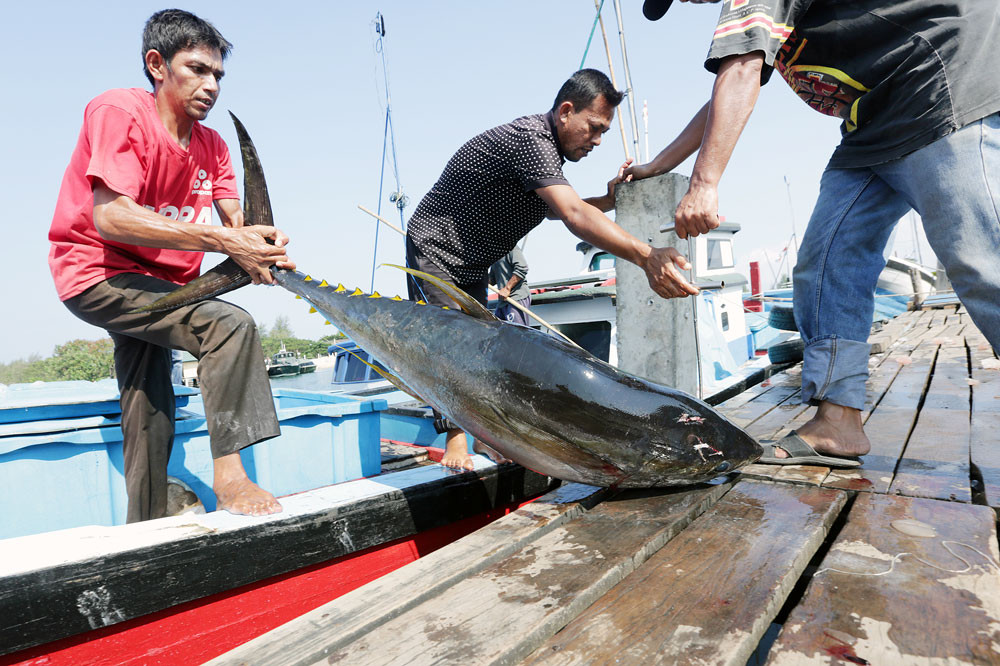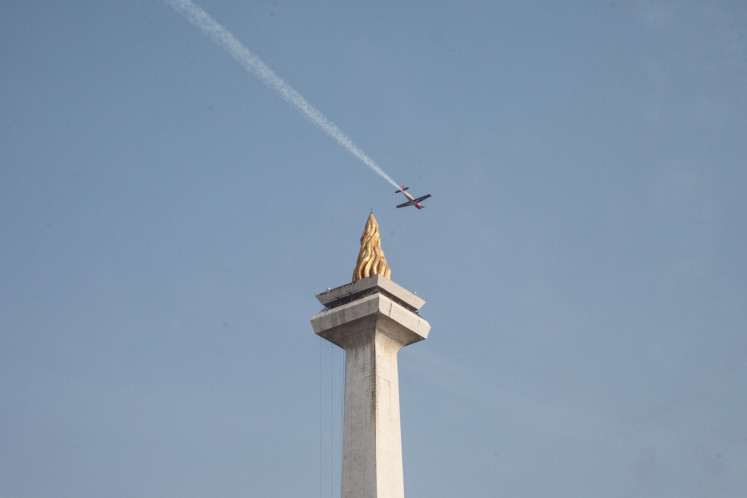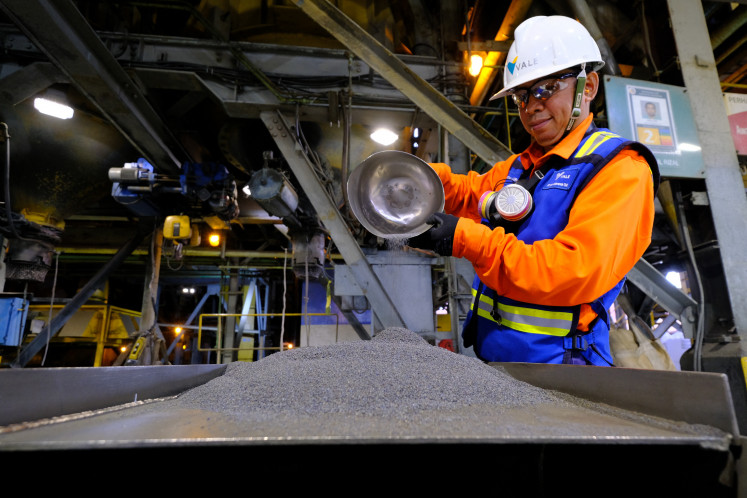Popular Reads
Top Results
Can't find what you're looking for?
View all search resultsPopular Reads
Top Results
Can't find what you're looking for?
View all search resultsWhy effective marine protected areas matter
Data from nongovernmental organizations (NGOs) and the government shows that well managed MPAs improve fish stocks and coral reefs.
Change text size
Gift Premium Articles
to Anyone
 Fishermen unload a tuna fish from a boat at Ulee Lheu Port in Banda Aceh, Aceh, on Wednesday. FAO State of World Fisheries and Aquaculture data shows that in 2018 Indonesia had the largest commercial catch of tuna in the world, contributing 16 percent to the global tuna market.
(Antara/Irwansyah Putra)
Fishermen unload a tuna fish from a boat at Ulee Lheu Port in Banda Aceh, Aceh, on Wednesday. FAO State of World Fisheries and Aquaculture data shows that in 2018 Indonesia had the largest commercial catch of tuna in the world, contributing 16 percent to the global tuna market.
(Antara/Irwansyah Putra)
I
ndonesia is the largest archipelagic nation in the world with 17,504 islands, a coastline of 108,000 kilometers, and 15.8 percent (27,255 square km) of the world’s coral reefs. Its economy and food security for the majority of its 270 million people are closely linked to marine and coastal resources.
Currently, around 70 percent of the country’s protein sources come from fish, and nearly 20 percent of the gross domestic product comes from fisheries and other marine-related industries, according to the Maritime Affairs and Fisheries Ministry.
Indonesia’s most diverse and rich marine life can be found in its eastern region, in the heart of the Coral Triangle, a vast tropical marine area including the waters of several nearby countries. The Coral Triangle houses nearly 600 reef building corals and over 2,000 species of reef fish, making it a true marine biodiversity hotspot.
To provide for its citizens and protect the globally significant biodiversity found in Indonesian waters, the nation must strengthen the sustainable management of its valuable marine resources.
While the government prioritizes conserving and managing its marine resources, the process is complicated and requires an indepth understanding by those responsible in government and its partners for it to succeed. There is progress toward effective marine conservation in Indonesia but much more needs to be done given existing threats to fisheries and the pending threat of climate change to marine habitats.
The coastal habitats in Indonesia are being exploited beyond their capacity from overfishing by more fishers using more efficient fishing gears, and coral reefs are being damaged from illegal and destructive fishing methods. These habitat losses are caused by lack of protection and management, which require planning and implementation of marine protected areas (MPAs) and other measures.
In response to the growing recognition of the loss of these valuable marine ecosystems, Indonesia is working to establish a marine protected area system through its national goal of having 30 million hectares of marine habitat in legally protected and managed MPAs by 2030.
But many of us do not understand the value of these MPAs to the country and what is needed to make them more effective. Most of us don’t realize that “legally protected” is not the same as actively managed and protected at the field level to achieve the desired benefits.
To help address the urgent need for building capacity for improved marine biodiversity conservation in Indonesia, the United States government through the US Agency for International Development Sustainable Ecosystems Advanced (USAID SEA) started in 2016 to work together with the ministry.
A major focus of USAID SEA is to build the capacity of MPAs in eastern Indonesia and to draw on lessons learned to inform us about what is needed to enhance protection of Indonesia’s valuable marine habitats and fisheries.
Indonesia has a national program for 201 MPAs that legally protect 237,684 square km of marine area, an area almost twice the size of Java Island, with controlled use or fishing zones and a small percent of no-extraction zones or commonly called “no-take zones” (NTZs).
When actively managed, MPAs and particularly NTZs within MPAs, are powerful tools to address local threats of overfishing and habitat destruction, enhance fisheries productivity, protect biodiversity, and increase resilience to changes in climate. They also enhance food security and sustainable livelihoods for communities and other stakeholders.
MPAs, particularly NTZs, can significantly increase fish abundance by two to three times compared to previously fished levels, increase the average fish size and the resulting number of fish eggs. This can occur in two to four years and immediately translate to increased catch outside NTZs when the areas are truly enforced.
One square km of a healthy and protected coral reef ecosystem can sustainably support a fish catch of more than 20 metric tons per year to local fishers which will translate to at least Ro 1.5 billion (US$100,000) in marketable value.
Data from nongovernmental organizations (NGOs) and the government shows that well managed MPAs improve fish stocks and coral reefs. Most MPAs in Indonesia fall under the jurisdiction of the ministry, which has delegated the management authority of most MPAs to local governments. However, the ministry and several international studies indicate that fewer than 15 percent of Indonesia’s MPAs are achieving their conservation objectives.
In response, the ministry has developed a tool to help local governments to measure and improve MPA effectiveness through a periodic review process to determine why the MPAs are not more effective.
While Indonesia is progressing with its marine resource management programs through the legal establishment of large MPAs with designated zones, it also needs to be more strategic in planning for the location of its MPAs so that the sites have an ecological connection for marine larvae to maximize benefits to fisheries.
The ministry and provincial programs need to focus more closely on the overall effectiveness from the ecological, management, and social perspectives. Doing so would unlock the full potential of MPAs for both conservation and advancing national development objectives.
USAID SEA works with the ministry and the provinces of North Maluku, Maluku and West Papua to protect the habitat for many threatened and protected species, including turtles, dugong, whales, sharks, extensive highly diverse coral reefs, and many seamounts.
Indonesia’s aim to achieve sustainable MPAs by 2030 also needs sustainable sources of funding. The country must identify financing opportunities to dramatically enhance the availability of financial resources from national and regional budgets (such as those under the low-carbon development framework) as well as non-state funding (such as the private sector).
While most MPA operations solely depend on national or local budgets, the USAID SEA Project analysis for improving sustainable funding suggested that more action is needed for leveraging sustainable financing outside of state funding and in some cases from the tourism sector.
The government working with the private sector needs to explore the establishment of public service agencies, public private partnerships and to promote corporate social responsibility actions and blended finance. Legitimate guidance from both the government and private sector to implement these actions is urgently needed to build and maintain these sustainable financing mechanisms.
In partnership with USAID SEA, the Indonesian government and coastal communities have taken substantial strides toward sustainable and effective MPAs through education, participatory planning and legalization of the MPAs. But, given the extensive marine areas that are not yet legally protected and the low rate of effective implementation in legally declared MPAs (<15 percent), much work remains to be done, and Indonesia can use the lessons learned in partnership with USAID SEA to jumpstart progress moving forward.
***
Agus Dermawan is a senior technical expert for marine and coastal ecosystem management at the Ministry of Marine Affairs and Fisheries and Alan White is chief of party of the USAID SEA Project. The views expressed are personal.









